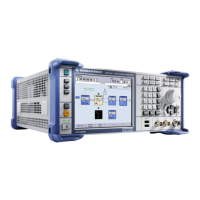Instrument Function
R&S
®
SMBV100A
308Operating Manual 1176.8016.02 ─ 17
Use the parameter Optimize internal IQ-Impairments for RF Output - Digital Impair-
ments to determine whether the optimization is performed for the RF signal or for the
signal at the differential I/Q output.
"Fast"
Optimization is reached by compensation for I/Q skew.
This mode is based on the standard calibration values and is provi-
ded for time sensitive environments.
"High Quality"
Optimization is reached by compensation for I/Q skew and frequency
response correction.
In this optimization mode, the instrument measures internally the fre-
quency response after every frequency and level change and auto-
matically applies the data in the internal equalizer. This results in an
extremely flat RF signal. The setting times, however, increases.
For information on the I/Q modulation performance, see the data
sheet.
Remote command:
[:SOURce<hw>]:BB:IMPairment:OPTimization:MODE on page 692
5.7.2 AWGN - Noise Generator
The noise generator generates an AWGN signal (Additive White Gaussian Noise) in
the digital baseband, i.e. the noise power density has a Gaussian distribution and is
distributed evenly across the frequency. This noise signal superimposes the (interfer-
ence-free) useful signal ("Additive Noise" mode). Typical applications for the noise
generator are bit-error or block-error measurements, depending on the set S/N or C/N
ratio.
The Gaussian noise is generated by means of feedback shift registers with subsequent
probability transformation. The switching configuration is such that virtually ideal statis-
tical characteristics are achieved:
●
I and Q paths are decorrelated from each other.
●
The crest factor of 18 dB allows very small probabilities to be realized.
●
The period of the noise signal depends on the selected system bandwidth. The
relationship of period P to system bandwidth B
sys
is approximated:
P ≈ 1*10
13
/ B
sys
This results in periods between 317 years with minimum bandwidth and approxi-
mately 2 days with maximum bandwidth.
This results in a period of approximately one month for 3GPP FDD with a band-
width of 3.84 Mcps, and a period of 427 days for GSM with 270.833 ksps.
Scalable low-pass filters are used to produce a noise power with both a broad dynamic
range and a broad bandwidth range (from 1 kHz to 60 MHz).
Apart from the "Additive Noise" mode, there are also the "Noise Only" and the "CW
Interferer" mode. In the "Noise Only" mode a pure noise signal is generated and modu-
lated to the carrier. In the "CW Interferer mode", a sinusoidal signal with an adjustable
frequency offset to the baseband signal is generated and added to the baseband sig-
nal by means of a counter instead of a shift register.
Impairment of Digital I/Q Signal and Noise Generator - AWGN/IMP Block

